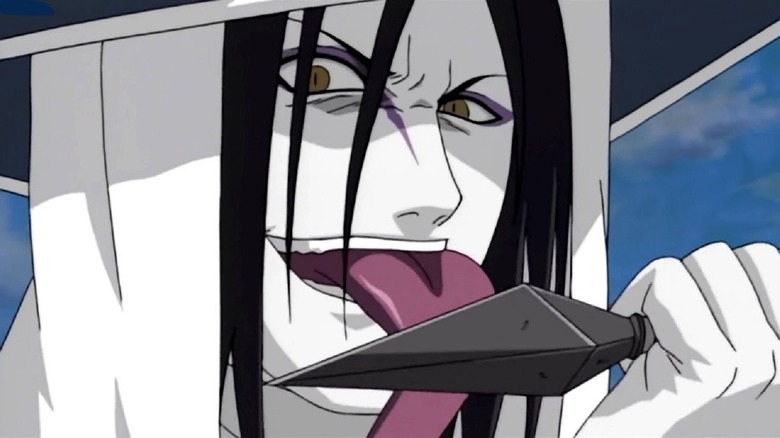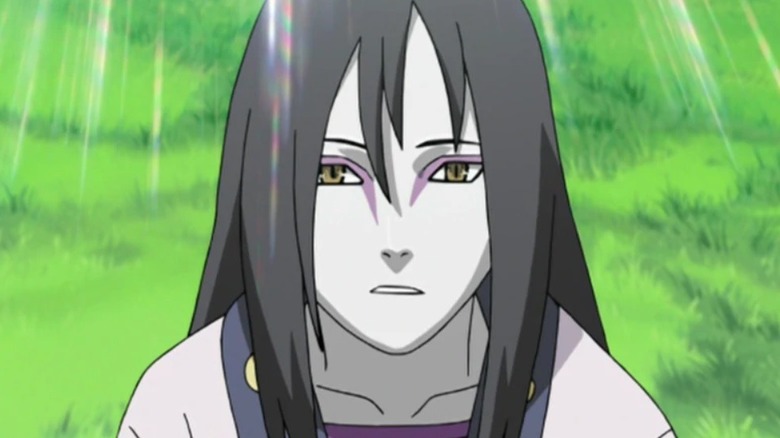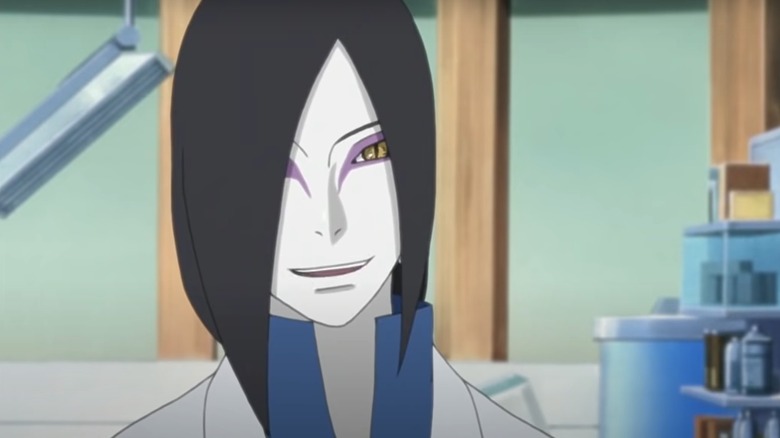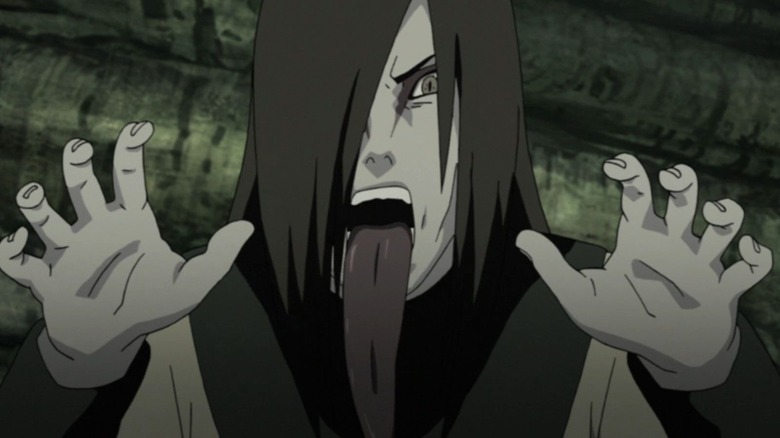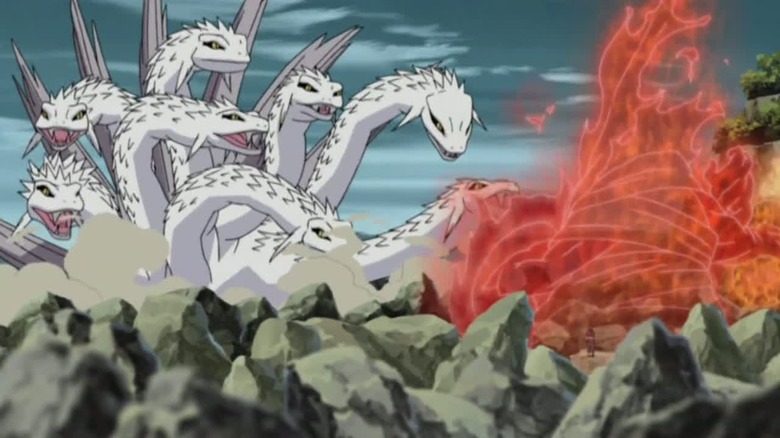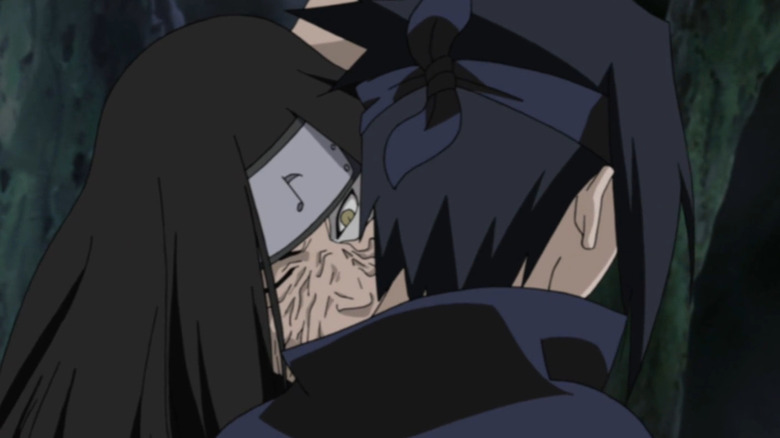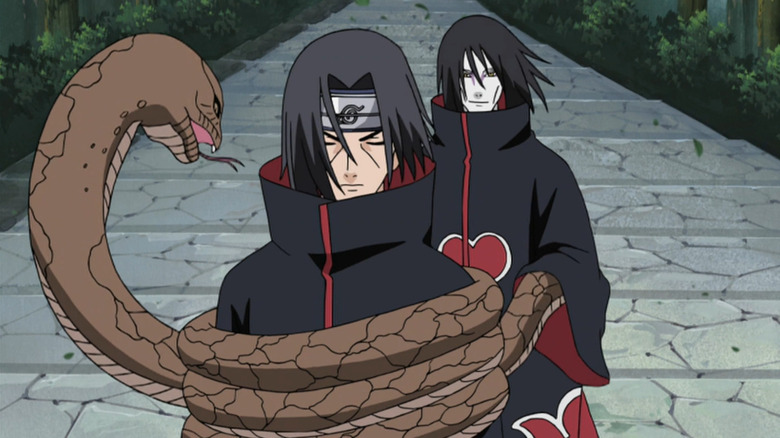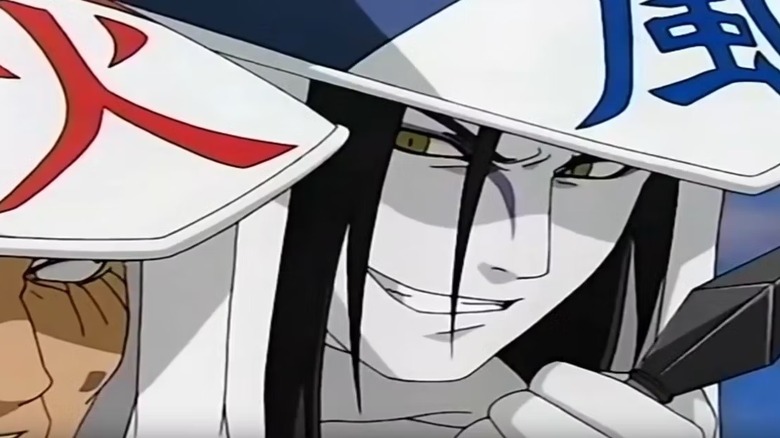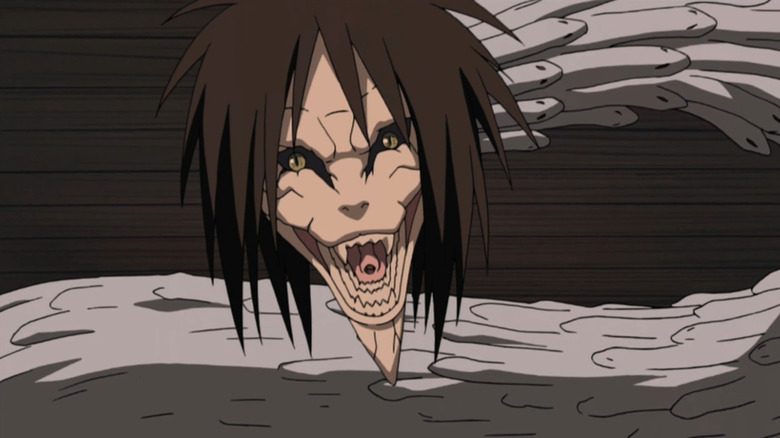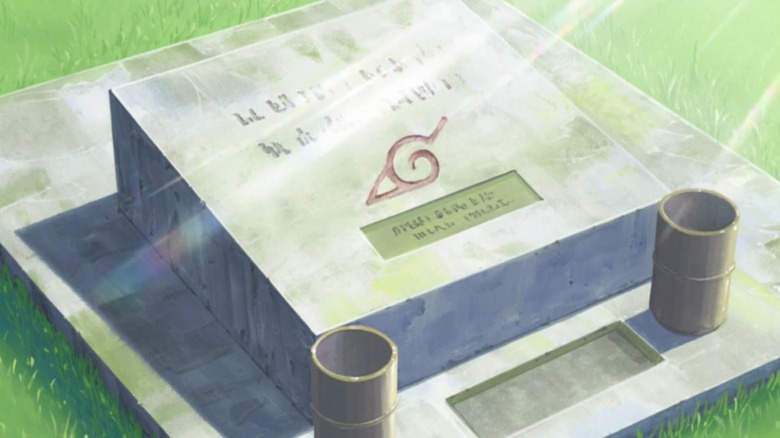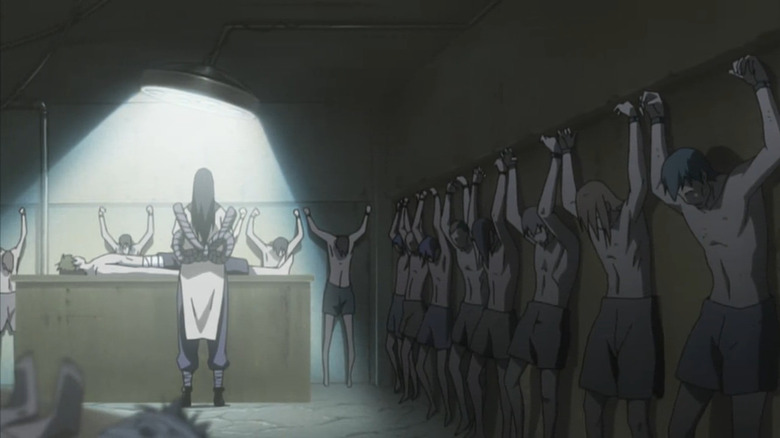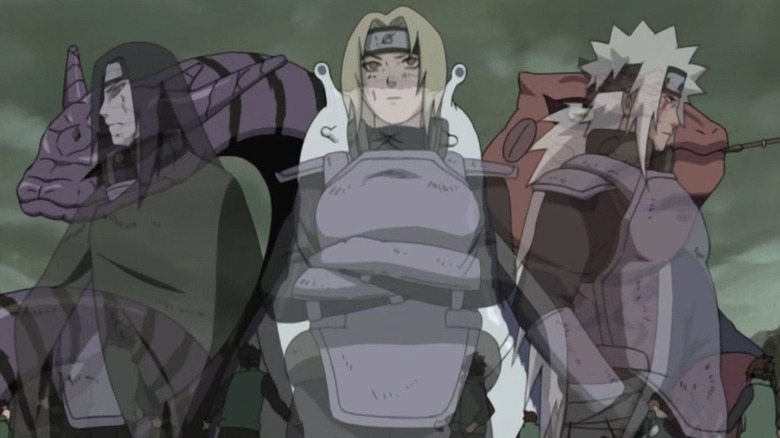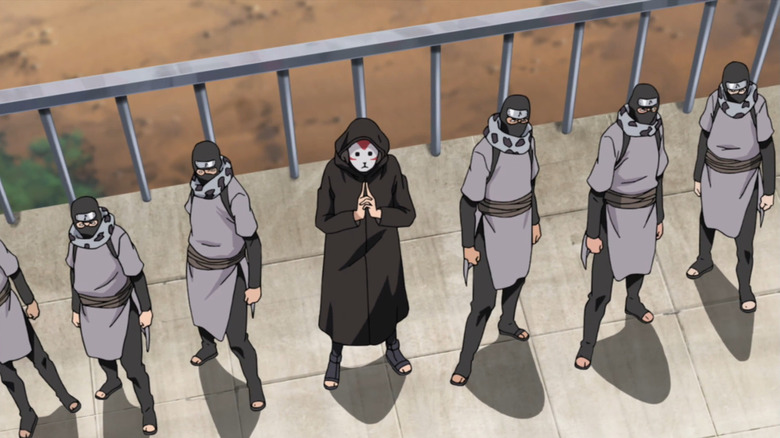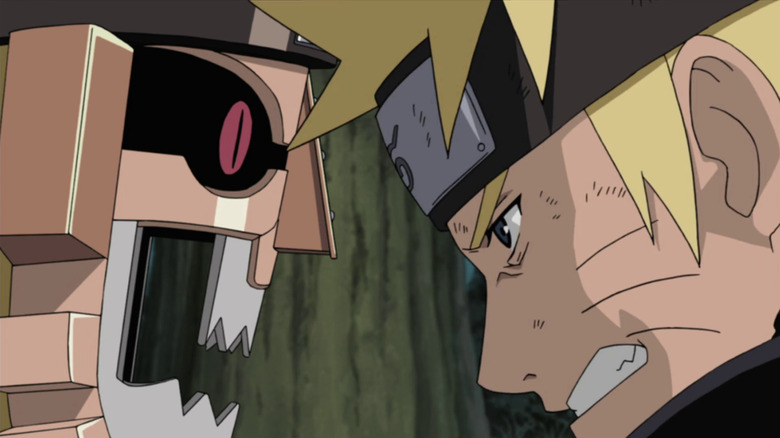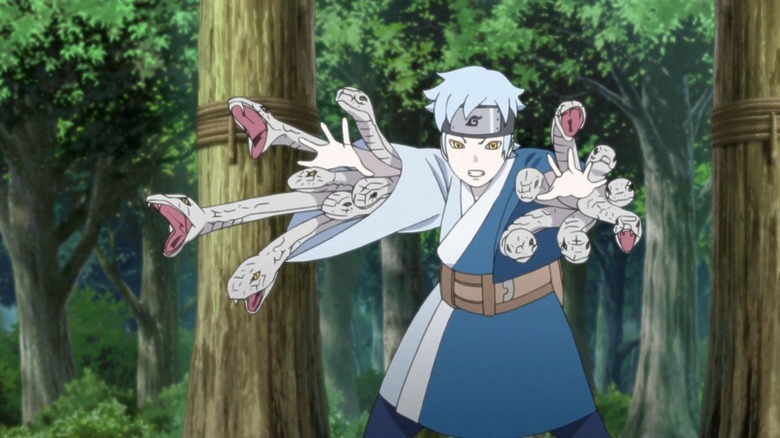The Untold Truth Of Naruto's Orochimaru
Do you think you know everything there is to know about Orochimaru? Well, think again. Sure, everyone remembers Orochimaru as the slimy, serpentine villain that tried to destroy the Village Hidden in the Leaves and made the life of Naruto Uzumaki a pain in the butt, but that was a long time ago. The Orochimaru of today, as seen in "Boruto: Naruto Next Generations," is aligned with the forces of good and the proud parent of a ninja boy named Mitsuki, who trains with the son of Naruto and Hinata Hyuga.
Orochimaru's transition from bad to good has been complicated. Some have criticized the new direction for the character, but it has opened up new and exciting story opportunities for the former villain. Furthermore, the new story arc for Orochimaru has led fans of the "Naruto" series to revisit the original anime and its sequel, "Naruto: Shippuden," to get a better read on the character. After all, no one is born evil. Do you want to know the real Orochimaru? Then read on. Spoilers ahead.
Orochimaru's creation was encouraged by Naruto editors
The Chunin Exams arc marks a significant turning point in "Naruto," a well-known storyline in which the students of the Academy are properly introduced. We get to know Hinata Hyuga and Rock Lee, as well as other ninja pupils outside the Village Hidden in the Leaves, like Gaara from Sunagakure (aka the Village Hidden by Sand). Perhaps the most important development during the Chunin Exams saga is the introduction of Orochimaru — and it almost never happened.
While Masashi Kishimoto, the creator of "Naruto," always had Orochimaru in his blueprints for the series, he didn't intend for the villain to play a big role in the Chunin Exams. In a 2014 interview with Fuji Television, Kishimoto revealed that his editorial team told him to introduce Orochimaru during the finals. Kishimoto said he was disappointed with the new direction of the story, as he enjoyed writing the tournament and planned on having Shikamaru Nara win at the end. However, he did admit that he wasn't sure how to write Shikamaru's path to victory, so perhaps it worked out for the best.
Orochimaru is gender fluid
While Orochimaru is often referred to as male by other characters (on account of inhabiting a male body), the one-time villain is in fact gender fluid. Orochimaru's ultimate goal is to uncover the mysteries of life, and doing that in a single human lifetime simply isn't possible. Therefore, Orochimaru set about trying to become immortal, conducting a series of cruel and twisted experiments. The serpentine terror discovered a way to possess the bodies of others for a period of three years, when the host would typically start to reject their unwanted visitor. Jumping from host to host, Orochimaru found a way to live forever. They have inhabited both male and female bodies over the years, doing this for so long that the concept of gender began to mean nothing.
In Episode 67 of "Boruto: Naruto Next Generations," Orochimaru's son (technically a modified clone) Mitsuki needs to get a form signed by a parent or guardian. He asks Orochimaru: "Are you my father or mother? What should I put down?" Orochimaru responds with: "That's a silly question. There have been times when I was a man, and times, a woman. As well as something not of this world. Outside appearances don't matter. The will to uncover all truth — that is the core of my being." It's a moment that was celebrated by fans as well as those involved with the show: The official English language "Boruto" Twitter account proudly called the reformed villain a "gender fluid icon."
Why snakes?
As a great movie archeologist once said: "Snakes. Why did it have to be snakes?" Well, in a flashback to Orochimaru's childhood, we learn that the orphan once found a white snake next to their parents' grave. When Orochimaru's teacher explained that snakes represent rebirth, the youngster was inspired, wanting to master all known ninja techniques and gain all knowledge to live forever. This isn't just a "Naruto" thing: Many cultures around the world view the snake as a symbol of immortality and rebirth due to the shedding of their skin.
Biblically speaking, the snake is the animal that the devil transforms himself into to trick Adam and Eve into committing the first sin. This is similar to Orochimaru scouting Sasuke Uchiha and eventually tempting him away from the Village Hidden in the Leaves with the promise of power to defeat his older brother, Itachi Uchiha. While "Naruto" uses Orochimaru's love of snakes as a way of conveying terror, it has some fun with the gimmick as well: The official "Naruto" databooks confirm that Orochimaru's favorite food is eggs.
Orochimaru is inspired by Japanese mythology
The creation of Orochimaru borrows heavily from the Japanese mythology of Yamata-no-Orochi (Eight-forked Giant Snake). Yamata-no-Orochi, or simply Orochi, is a legendary Japanese dragon/serpent with eight heads and eight tails who devoured the daughters of a poor family every year and was about to take his eighth victim until he was defeated by divine intervention. The mythical creature was killed by the god Susa-no-O. Upon slaying the Yamata-no-Orochi, Susa-no-O stumbled upon the Kusanagi Sword in one of the monster's tails.
The folklore is incredibly similar to the battle between Orochimaru and Itachi Uchiha in Episode 138 of "Naruto: Shippuden," during which Orochimaru uses the Eight Branches Technique to transform into a giant eight-headed snake monster. Itachi decapitates seven of the snakes, encases himself in his Susanoo form and uses the Totsuka Sword to seal Orochimaru away. It's an epic moment that has its roots in Japanese folklore.
Orochimaru's soul is in every cursed seal
The Juinjutsu (meaning Cursed Seal Techniques) are designed to bring people under the control of the user. By biting someone and injecting senjutsu chakra, Orochimaru essentially inserts a piece of their own consciousness into the victim. While Sasuke Uchiha was able to up his chakra game and boost his physical abilities with his cursed seal during the Chunin Exams, it came after experiencing excruciating pain from its infliction by Orochimaru.
The seal itself has a one-in-ten success rate, as evidenced by Anko Mitarashi being the only one in her group to survive the application. While Orochimaru was able to assert dominance over Sasuke early on through the cursed seal, Sasuke was eventually able to work around it and deliver the final blow to Orochimaru. However, thanks to a fragment of their consciousness still existing in Anko's cursed seal, Orochimaru was able to come back to life through the use of the Evil Releasing Method.
Orochimaru lost his left hand to Itachi Uchiha
Before the Third Hokage sacrificed his life to seal Orochimaru's arm, Itachi Uchiha gave the serpentine villain a lesson they would never forget. In Episode 114 of "Naruto: Shippuden," a flashback of Orochimaru's time in the Akatsuki (the overarching threat during the original "Naruto" anime) was shown. Orochimaru was initially a good subordinate for the Akatsuki, but a desire for power got the better of the snake-lover when Itachi and his prized Sharingan (or Mirror Wheel Eye in the English version) joined the group.
Originally, Orochimaru planned to transfer their soul into Itachi's body, but the older brother of Sasuke was one step ahead. Itachi used his Sharingan to trap Orochimaru in a genjutsu called Demonic Illusion: Shackling Stakes Technique, a gruesome ability that makes the target feel the sensation of having spikes driven through their body. He then used the opportunity to cut off Orochimaru's left arm to prevent the villain from breaking the technique now and in the future. In hindsight, Orochimaru losing just one arm to Itachi was more merciful than Hiruzen Sarutobi cutting them both off with the Dead Demon Consuming Seal.
Orochimaru was once a prodigy
Losing Orochimaru to the dark side was a devastating blow to the Village Hidden in the Leaves, as Hiruzen Sarutobi considered the skilled shinobi to be a prodigy. As stated in the official "Naruto" databooks, Orochimaru completed 1,468 official missions during his time as a shinobi for the Village Hidden in the Leaves. Orochimaru's performance in the Third Shinobi War was so impressive that Hiruzen believed his pupil was a strong contender for the Fourth Hokage, as mentioned in the book "Itachi Shinden: Book of Bright Light." However, Orochimaru's twisted personality and dark agenda were hard to overlook. So why didn't Hiruzen see the red flags?
Like Obi-Wan Kenobi and Anakin Skywalker in "Star Wars," Hiruzen incorrectly believed that he could persuade Orochimaru to stay on the good side. Hiruzen's naivety would cost him and his people — Orochimaru invaded the Village Hidden in the Leaves during the Chunin Exams and was discovered to have been conducting inhumane experiments. Even in his prime, Hiruzen didn't believe he was strong enough to defeat Orochimaru. And, considering the outcome of their battle at the Chunin Exams, he was right to think that. The Third Hokage was only able to subdue his former pupil by sacrificing his life.
Orochimaru's true form is a giant snake
While Orochimaru's original human form was lost a long time ago due to all the body-hopping, the character still retains their true form, that of a huge snake. The Power of the White Snake transforms Orochimaru into a monstrous version of their favorite cold-blooded reptile. It's a form that makes it clear how little humanity remains inside of Orochimaru. On top of a horrifying appearance, the Power of the White Snake grants Orochimaru amazing healing abilities, as well as activating their Living Corpse Reincarnation technique to possess another person's body.
Orochimaru used this technique in an attempt to take over Sasuke's body in Episode 114 of "Naruto: Shippuden," titled "Eye of a Hawk." Despite years of planning, Orochimaru wasn't able to overcome the awesome power of Sasuke's Sharingan eye and ironically became a prisoner in Sasuke's body. It's an unforgettable moment that honestly went too far in its grossness.
The meaning behind Orochimaru's name
Disregarding Orochimaru's fateful encounter with a white snake at their parents' grave, the sinister shinobi was always destined to have a strong bond with serpents. Why? Because it's literally in their name. "Orochi" translates to "large snake/serpent," while "maru" is a common suffix in Japanese male names. What about the surname? Well, Orochimaru is unfortunately one of the few characters in the "Naruto" franchise who is only referred to by a first name. In Episode 114 of "Naruto: Shippuden," a flashback showing the grave of Orochimaru's parents seems to show the last name of the family. Unfortunately for fans, the text on the memorial stone is blurred and unreadable.
Despite the illegibility, the grave does show that Orochimaru's parents had surnames. Orochimaru, for reasons unknown, decided not to use them for their own identity. Considering how painful the loss of their parents was, perhaps Orochimaru just wanted to create emotional distance from the tragic event.
Orochimaru's experiments were too graphic for TV
The original "Naruto" series could get pretty graphic for a show about children learning to become ninjas. While the anime contained some intense scenes — like the classic moment where Naruto stabs his hand to make a vow of blood that he would never cower from a fight again — it also tamed a few scenes from the manga that were too much for its younger viewers. The best example of this is the censoring of Orochimaru's lab, where the villain conducted his human experimentation.
Shown near the end of the Chunin Exams, the ninjas of the Village Hidden in the Leaves catch Orochimaru red-handed experimenting on dead human bodies. In the manga, Orochimaru is surrounded by corpses and blood is splattered all over the walls. The anime version of this haunting flashback, however, removes the dead bodies for a more generic lab setting. Anime fans wouldn't get a good look at Orochimaru's horrible experimentations until "Naruto: Shippuden," where the flashback accurately depicts what was originally shown in the manga.
Team Hiruzen
Orochimaru, Jiraiya, and Tsunade were all part of the same ninja team growing up: Team Hiruzen. That's right, Hiruzen Sarutobi, the Third Hokage. Much like how the creation of Orochimaru is based on Japanese mythology, the names of Hiruzen's pupils are inspired by the Japanese folk story "The Tale of the Gallant Jiraiya." In the story, Orochimaru (real name Yashagoro) was originally a student of Jiraiya. After being corrupted by snake magic, Yashagoro changed his name to Orochimaru.
Back to "Naruto" now. Team Hiruzen was nicknamed The Legendary Sannin, as they were the only ones who survived the devastating attacks of legendary shinobi Hanzo of the Salamander during the Second Shinobi War. Despite their impressive accomplishments together, Team Hiruzen was in constant disagreement. Tsunade would describe these heated arguments as a "three-way deadlock." One significant argument that shows the true morality of the team members involved the war orphans from the Village Hidden by Rain: Orochimaru wanted to end their misery, while Jiraiya decided to stay behind and train them.
The Village Hidden in the Sound
As big a menace as Orochimaru was in the original "Naruto" anime, the serpentine terror could have never pulled off the invasion of the Village Hidden in the Leaves alone. A leader is nothing without their followers, and Orochimaru's pawns were the poor civilians of the Village Hidden in the Sound. This was less a village and more a network of laboratories across the land that allowed Orochimaru to continue experimenting in peace. It was also the place where Orochimaru duped cut-throat ninjas into doing their bidding, such as Team Dosu, who were tricked into sacrificing themselves.
The Village Hidden in the Sound was initially a cover-up for Orochimaru's secret hideout for cruel experiments. However, as the years went by and Orochimaru transitioned into a good character, the Village Hidden in the Sound became a legitimate village that trains shinobi in the vein of the Village Hidden in the Leaves.
Orochimaru created the Mecha-Naruto
Orochimaru is responsible for some of the most unholy experiments in the whole "Naruto" franchise. However, there is one creation that's more silly than scary. In Episode 376 of the "Naruto: Shippuden" anime, Orochimaru gives life to a mechanical monstrosity known as the Mecha-Naruto. Although Orochimaru created the Mecha-Naruto as a way of capturing the Nine-Tails demon fox that lies within the real Naruto Uzumaki, the creation nearly took them and their assistant Kabuto Yakushi out.
It should be stated that Mecha-Naruto does not exist in the manga — he was invented by series creator Masashi Kishimoto for the game "Naruto Shippuden Ultimate Ninja Storm Revolution." Mecha-Naruto makes various appearances in the "Naruto Shippuden Ultimate Ninja" games, even developing a crush on Hinata Hyuga in one of them. The name Mecha-Naruto is, of course, a nod to Mecha-Godzilla from the "Godzilla" franchise. Kishimoto was reportedly a huge fan of "Godzilla" films as a kid and wanted to pay tribute to them.
Orochimaru has a clone son
Orochimaru turning over a new leaf in "Boruto: Naruto Next Generations" might have been a shock to the system for long-time "Naruto" fans, but that's not even the biggest reveal in the sequel series: Jaws hit the floor when it was revealed that the reformed villain is now a parent to a young boy named Mitsuki. Of course, fans immediately began to ask questions about the circumstances of Mitsuki's birth. It turns out that Mitsuki was created as a modified clone of Orochimaru, cultivated from the same embryo as at least one older "Mitsuki."
Orochimaru wanted Mitsuki to forge his own destiny, which is why the former villain concocted a complex plot that would result in Mitsuki rebelling against his parent and gaining his independence. Mitsuki's journey, as fans of "Boruto" know, would lead him to enlist as a shinobi-in-training at the Village Hidden in the Leaves and befriend Naruto's son, Boruto Uzumaki. While Orochimaru and Naruto (now the Hokage) have a relationship based on mutual respect alone, Mitsuki and Boruto are actually genuine friends, which is great to see. It's an outcome that fans would have never predicted back when Orochimaru first showed up in "Naruto" all those years ago.
